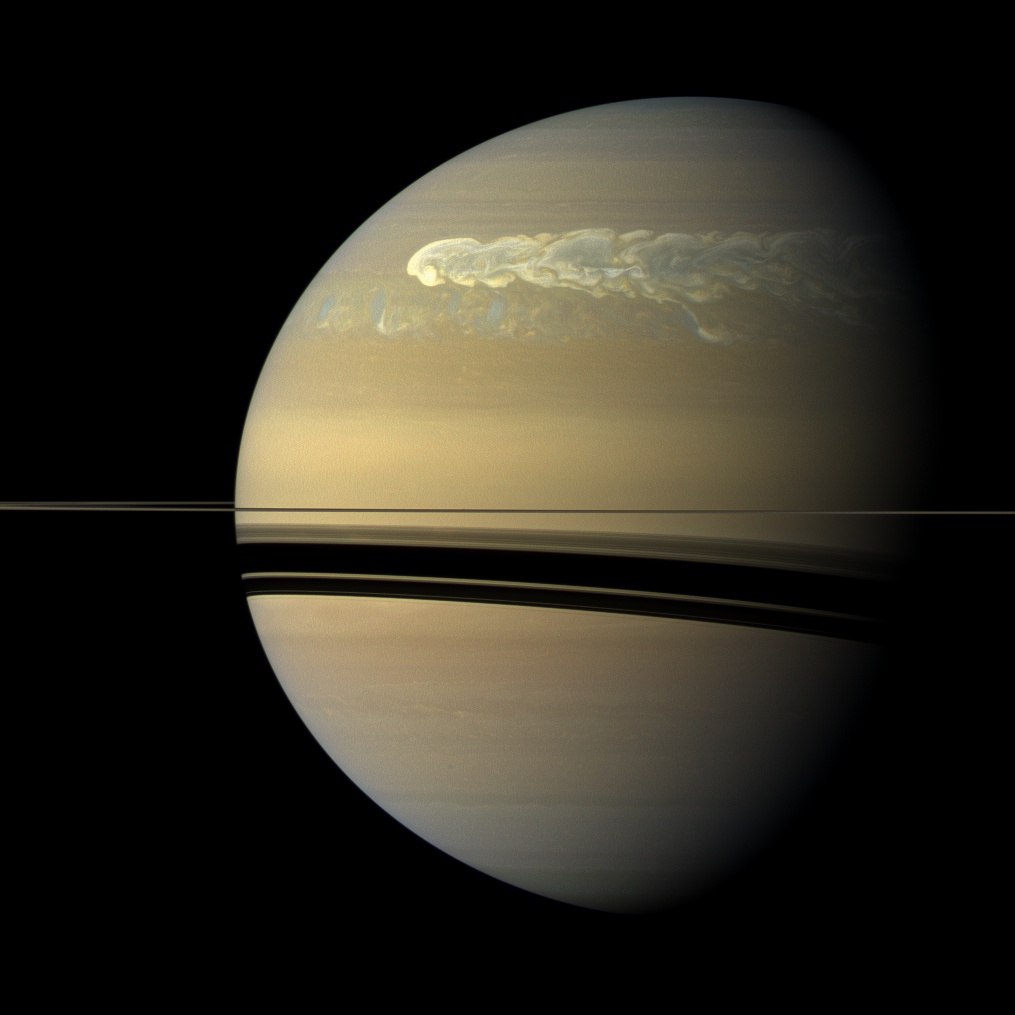Saturn (Saturne) is a gas giant with an average radius of about nine and a half times that of Earth. It has only one-eighth the average density of Earth, but is over 95 times more massive.
Saturn’s interior is most likely composed of a rocky core, surrounded by a deep layer of metallic hydrogen, an intermediate layer of liquid hydrogen and liquid helium, and finally, a gaseous outer layer. Saturn has a pale yellow hue due to ammonia crystals in its upper atmosphere. An electrical current within the metallic hydrogen layer is thought to give rise to Saturn’s planetary magnetic field, which is weaker than Earth’s, but which has a magnetic moment 580 times that of Earth due to Saturn’s larger size. Saturn’s magnetic field strength is around one-twentieth of Jupiter’s.
The outer atmosphere is generally bland and lacking in contrast, although long-lived features can appear. Wind speeds on Saturn can reach 1,800 kilometres per hour (1,100 miles per hour), higher than on Jupiter but not as high as on Neptune.
The planet’s most notable feature is its prominent ring system, which is composed mainly of ice particles, with a smaller amount of rocky debris and dust. At least 83 moons are known to orbit Saturn, of which 53 are officially named; this does not include the hundreds of moonlets in its rings. Titan, Saturn’s largest moon and the second largest in the Solar System, is larger (while less massive) than the planet Mercury and is the only moon in the Solar System to have a substantial atmosphere.

A persisting hexagonal wave pattern around the north polar vortex in the atmosphere at about 78°N was first noted in the Voyager images. The sides of the hexagon are each about 14,500 km (9,000 mi) long, which is longer than the diameter of the Earth. The entire structure rotates with a period of 10h 39m 24s (the same period as that of the planet’s radio emissions) which is assumed to be equal to the period of rotation of Saturn’s interior. The hexagonal feature does not shift in longitude like the other clouds in the visible atmosphere. The pattern’s origin is a matter of much speculation. Most scientists think it is a standing wave pattern in the atmosphere. Polygonal shapes have been replicated in the laboratory through differential rotation of fluids.
土星属氣體(類木)巨行星。古代中国亦称之为鎮星(常写作填星)。土星是中国古代人根据五行学说结合肉眼观测到的土星的颜色(黄色)来命名的(按照五行学说即木青、金白、火赤、水黑、土黄)。而其他语言中土星的名称基本上来自希臘/羅馬神話传说,例如在欧美各主要语言(英语、法语、西班牙语、俄语、葡萄牙语、德语、意大利语等)中土星的名称来自于羅馬神話中的农业之神萨图尔努斯(拉丁文:Saturnus),其他的还有希臘神話中的克洛諾斯(泰坦族,宙斯的父親,一说其在罗马神话中即萨图尔努斯)、巴比倫神话中的尼努尔塔和印度神话中的沙尼。土星的天文符號是代表农神萨图尔努斯的鐮刀(Unicode: ♄)。土星主要由氫組成,還有少量的氦與微痕元素,內部的核心包括岩石和冰,外圍由數層金屬氫和氣體包覆著。